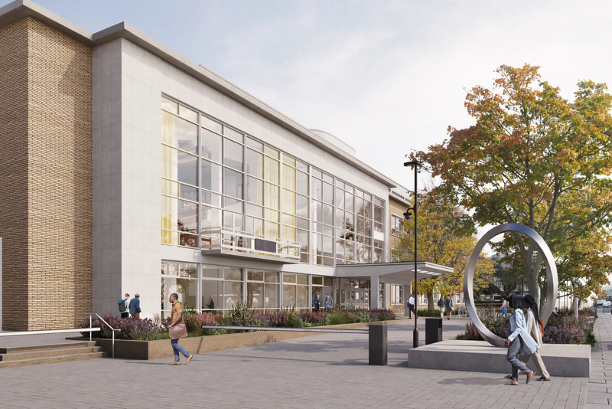Creating an Effective Workplace for a New Era of Public Service
Public sector organisations face unique pressures when it comes to workplace transformation. Balancing civic duty with modern workstyles, budgets with employee expectations, and tradition with innovation requires more than just a property-led solution. It demands a holistic workplace strategy that puts people, purpose, and performance at its core.
Our work with a major local authority illustrates how a workplace can be reimagined not only to fit today’s hybrid needs but also to future-proof against the unknown challenges of tomorrow.
The Challenge
The Council’s Civic Centre was a critical workplace hub, yet feedback from staff and utilisation data painted a challenging picture:
- Assigned desks dominated: Staff gravitated towards fixed desks with monitors, reflecting both cultural comfort and technological limitations. Other settings like hot-desks, pods, and booths were underused.
- Hybrid adoption gaps: Despite the rise of hybrid work, space patterns were still rooted in pre-pandemic ways of working. Collaboration and social spaces were underutilised, while noise from shared environments emerged as a key frustration.
- Facilities and technology frustrations: Staff cited issues ranging from poor Wi-Fi and broken IT equipment to basic facilities such as toilets, lifts, and kitchens. These frustrations were daily barriers to productivity.
- Cultural resistance: People valued predictability and familiarity, with a strong attachment to traditional seating arrangements. Without change management, new ways of working risked being rejected.
The task was to design a strategy that addressed these barriers, built confidence in change, and created an effective, flexible workplace ready for the future of hybrid public service delivery.
Our Approach
We applied the Destination 2.0 lens across People, Place, Purpose, and Platforms to ensure the project went beyond desks and floorplans. The process included:
- Staff surveys and engagement workshops to understand behaviours, aspirations, and cultural sensitivities.
- Utilisation studies to capture actual occupancy, peak demand, and daily flow across work settings.
- Scenario modelling to test different headcount assumptions and future patterns of office presence.
- Change management planning to ensure leaders, managers, and staff were ready for the journey ahead.
This multi-layered approach meant that the strategy addressed not just space but also technology, culture, and the lived experience of staff.
Key Insights
From this work, four critical insights emerged:
- Change must be co-created – People prefer predictability. To overcome resistance, change management had to be embedded into the design process, giving staff ownership of the solutions.
- Effective Workplace (EW) as a metric – Traditional workstation ratios were not enough. A new measure was introduced, calculating how each setting contributes to “effective work.” This future-proofed the Civic Centre against unpredictable hybrid attendance patterns.
- Hybrid requires different zoning – With home handling much of the focus work, the office needed to shift towards collaboration, problem solving, and learning. Zoning principles were proposed to balance focus with group activity while mitigating noise.
- Technology and facilities matter – From broken screens to poor Wi-Fi and uninspiring kitchens, staff frustrations were loud and clear. Investment in user-friendly IT, room booking, and improved facilities was non-negotiable to rebuild trust.
From Insight to Strategy
The future workplace vision was organised around “districts”—neighbourhoods with distinct personalities and utilities, much like the borough itself. Each district offered a different mix of settings, from formal desks and study rooms to informal lounges, pods, and collaborative nooks.
- Effective Workplace Kit: Each setting was given an EW score based on how well it could support long-term, ergonomic work. This created resilience by ensuring enough “effective” places to work even if attendance increased.
- Balanced Zoning: Floors were landscaped to separate collaborative and quiet areas, addressing noise issues while supporting diverse work modes.
- Amenities & Wellbeing: Recommendations included upgraded kitchens, modernised toilets, wellness spaces, and biophilic elements such as greenery and natural light.
- Technology Overlay: A plug-and-play IT strategy, integrated room booking, and reliable Wi-Fi were designed to create a seamless, frustration-free digital experience.
- Change Roadmap: Recognising the cultural journey, the strategy prepared leaders and teams for a “double J-curve” of adoption. Pilots, champions, and training were all built into the plan.
The Outcome
The result was a comprehensive workplace strategy that reframed the Civic Centre as more than just a building. It became a tool to:
- Support hybrid working with flexibility and resilience.
- Empower staff with choice, confidence, and better technology.
- Create a civic workplace that reflected the borough’s culture and purpose.
- Future-proof against unpredictable demands with the Effective Workplace metric.
- Build pride and belonging by transforming facilities and social spaces.
Why It Matters
For public sector organisations, the stakes of workplace transformation are particularly high. Budgets are limited, demands are rising, and staff need environments that both support productivity and reflect the civic values they serve.
This project demonstrates how the right strategy can turn a traditional, desk-heavy office into a flexible, engaging, and future-ready workplace—one that empowers people, strengthens purpose, and delivers long-term value for the community.




